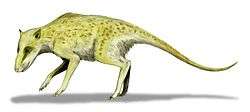Indohyus
| Indohyus Temporal range: Middle Eocene | |
|---|---|
 | |
| Indohyus major | |
| Scientific classification | |
| Kingdom: | Animalia |
| Phylum: | Chordata |
| Clade: | Synapsida |
| Class: | Mammalia |
| Order: | Artiodactyla |
| Family: | †Raoellidae |
| Genus: | †Indohyus Rao 1971 |
| Species | |
|
I. indirae | |
Indohyus ("India's pig") is a genus of extinct digitigrade artiodactyl known from Eocene fossils in Asia. This small deer-like animal found in the Himalayas is a close relative of whales.[1]
Description

The fossils were discovered among rocks that had been collected more than 30 years ago in Kashmir by the Indian geologist A. Ranga Rao who found a few teeth and parts of a jawbone,[2] but when he died many rocks had yet to be broken open. Ranga Rao's widow gave the rocks to Professor Thewissen, who was working on them when his technician accidentally broke one of the skulls they had found and Thewissen recognised the ear structure of the auditory bulla, formed from the ectotympanic bone in a shape which is highly distinctive, found only in the skulls of cetaceans both living and extinct, including Pakicetus.[3]
About the size of a raccoon or domestic cat, this herbivorous deer-like creature shared some of the traits of whales, and showed signs of adaptations to aquatic life, including a thick and heavy outer coating. Their bones were similar to the bones of modern creatures such as the hippopotamus, and helped reduce buoyancy so that they could stay underwater.[4] This suggests a similar survival strategy to the African mousedeer or water chevrotain which, when threatened by a bird of prey, dives into water and hides beneath the surface for up to four minutes.[3][4][5]
Taxonomy
A December 2007 article in Nature by Thewissen et al. used an exceptionally complete skeleton of Indohyus from Kashmir to indicate that raoellids may be the "missing link" sister group to whales (Cetacea).[6][7] All other Artiodactyla are "cousins" of these two groups. δ18O values and osteosclerotic bones indicate that the raccoon-like or chevrotain-like Indohyus was habitually aquatic, but δ13C values suggest that it rarely fed in the water. The authors suggest this documents an intermediate step in the transition back to water completed by the whales, and suggests a new understanding of the evolution of cetaceans.
However, not all paleontologists are firmly persuaded that Indohyus is the transitional fossil that cetacean-origin experts were looking for. O'Leary & Gatesy 2008[8] postulates an extinct group of carnivorous mammals called "mesonychids" as more closely related to cetaceans. Additionally, ScienceNOW, a daily news feature of the journal Science, notes that "cetaceans are so different from any other creature that researchers haven’t been able to agree which fossil relatives best represent their nearest ancestors."[9]
Two species have been described.
- Genus Indohyus
- I. indira
- I. major
Notes
References
- Bajpai, S; Thewissen, JG; Sahni, A (November 2009). "The origin and early evolution of whales: macroevolution documented on the Indian subcontinent". J Biosci. 34 (5): 673–86. doi:10.1007/s12038-009-0060-0. OCLC 565869881. PMID 20009264.
- Minkel, JR (December 19, 2007). "Closest Whale Cousin — A Fox-Size Deer? Researchers split on closest evolutionary kin to whales and dolphins". Scientific American.
- Myers, PZ (19 December 2007). "Indohyus". Pharyngula. ScienceBlogs. Retrieved December 2007. Check date values in:
|access-date=(help) - O'Leary, Maureen A; Gatesy, John (August 2008). "Impact of increased character sampling on the phylogeny of Cetartiodactyla (Mammalia): combined analysis including fossils" (PDF). Cladistics. 24 (4): 397–442. doi:10.1111/j.1096-0031.2007.00187.x. Retrieved February 2013. Check date values in:
|access-date=(help) - Rao, A Ranga (1971). "New mammals from Murree (Kalakot Zone) of the Himalayan foot hills near Kalakot, Jammu and Kashmir state, India". Journal of the Geological Society of India. 12 (2): 124–34.
- Sample, Ian (19 December 2007). "Whales may be descended from a small deer-like animal". London: Guardian. Retrieved December 2007. Check date values in:
|access-date=(help) - Thewissen, JGM; Cooper, LN; Clementz, MT; Bajpai, S; Tiwari, BN (2007). "Whales originated from aquatic artiodactyls in the Eocene epoch of India". Nature. 450 (7173): 1190–4. Bibcode:2007Natur.450.1190T. doi:10.1038/nature06343. PMID 18097400.
- Stokstad, Erik (19 December 2007). "Long-Lost Relative of Whales Found?". Science NOW Daily News. Retrieved December 2007. Check date values in:
|access-date=(help) - Zimmer, Carl (December 19, 2007). "Whales: From So Humble A Beginning...". The Loom, ScienceBlogs. Retrieved December 2007. Check date values in:
|access-date=(help)